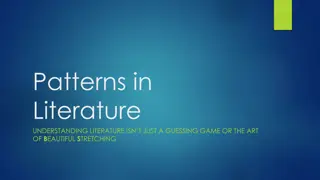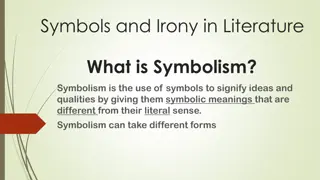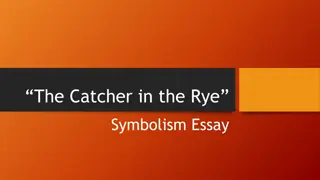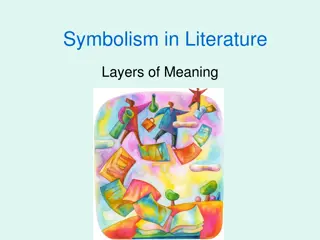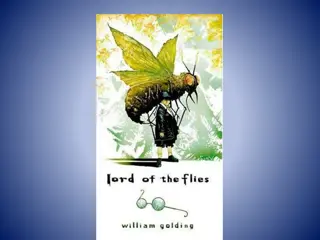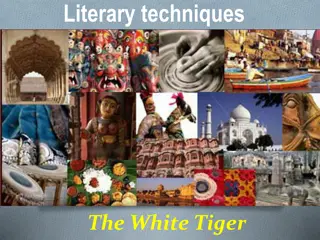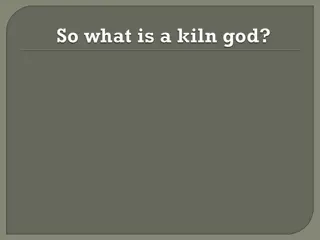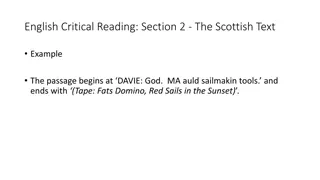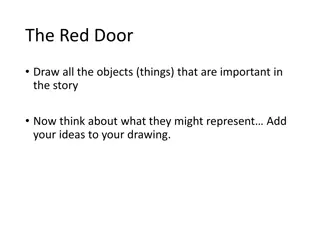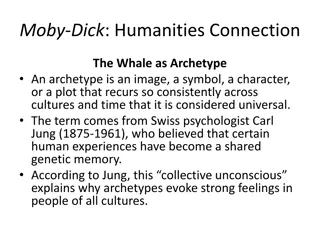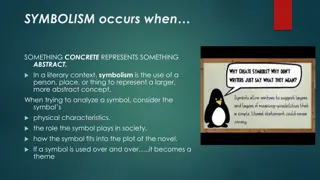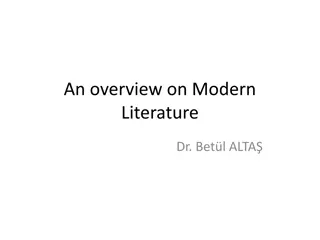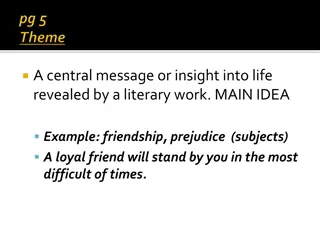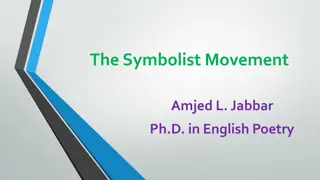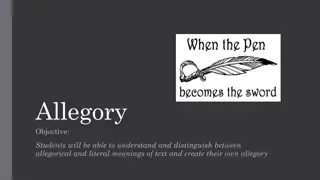Unveiling the Depths of Symbolism in Literature
Delve into the world of symbols and motifs that transcend the obvious meanings, exploring how objects and elements in literature can represent deeper themes and ideas. Discover how symbolism is used to convey emotions, atmosphere, and key concepts, with examples that showcase the intricate layers of meaning hidden within literary works.
Uploaded on Oct 09, 2024 | 0 Views
Download Presentation

Please find below an Image/Link to download the presentation.
The content on the website is provided AS IS for your information and personal use only. It may not be sold, licensed, or shared on other websites without obtaining consent from the author. Download presentation by click this link. If you encounter any issues during the download, it is possible that the publisher has removed the file from their server.
E N D
Presentation Transcript
Symbols and Motifs Meaning beyond Meaning beyond the obvious the obvious
A symbol is an object that stands for itself and a greater idea. We see symbols every day
Symbols and Symbolism A symbol is anything that hints at something else, usually something abstract, such as and idea or belief. A literary symbol is an object, a person, a situation, or an action that has a literal meaning in a story but suggests or represents other meanings beyond what is written.
Symbolism as Mood/Atmosphere When an author wants to suggest a certain mood or emotion, he can also use symbolism to hint at it, rather than just blatantly saying it. Example: Transition from day to night might = move from goodness to evil Example: A storm occurring when there is a conflict or high emotions
Symbolism in Literature Objects are often used as symbols. An object is meaningful symbolically only in the context of the literature. For instance, a chain can symbolize the coming together of two things or a sense of imprisonment.
Symbolism is used to emphasize key ideas or themes. A river can represent the flow of life or its depth may represent the unknown the water might be purity or there could be dangers beneath the surface.
How can you spot a symbol? There s no one way, but some things to look for are: Unusual character names Beneatha (in A Raisin in the Sun) Objects / creatures that have cultural meanings (lions = strength, owls = wisdom, etc.)
Symbols in The Pearl? The pearl = greed, success, destruction, hope, The scorpion = evil, destruction of innocence Canoe = cultural tradition
So, the next time you read a novel, watch out for what s not written in the words. P.S. What does a butterfly often symbolize?
Motifs A recurring image, word, phrase, or action that tends to create unity within a literary work. Sometimes the motif helps to create the theme in literature A motif differs from a theme in that it can be expressed as a single word or fragmentary phrase, while a theme usually must be expressed as a complete sentence
Motif Examples A recurring motif in George Orwell's "1984" is urban decay. Winston Smith's run-down home, London's crumbling buildings, and the overall disintigration of the city all support Orwell's theme of the miserable results of total government control.
Motif Examples Clothing Seasons Colors Death Supernatural Adversaries Consequences of Greed Beautiful Princess Wishes Magical Objects Magical Powers Deep Sleeps Wishes Trickery Illness Animals Foolish Hero


